CCNA 4 Chapter 2 Question and Answer
(Total 23 Question and Answer)

1. Refer to the exhibit.
Router R1, the DCE device, has just been configured for PPP encapsulation with authentication. What series of commands will allow another router, the DTE device, to communicate over its serial 0/0/0 interface to router R1?
Router(config)# hostname R3
R3(config)# username R1 password Cisco
R3(config)# interface Serial 0/0/0
R3(config-if)# encapsulation ppp
R3(config-if)# ip address 172.16.3.3 255.255.255.0
R3(config-if)# ppp authentication chap
Router(config)# hostname R3
R3(config)# username R3 password Cisco
R3(config)# interface Serial 0/0/0
R3(config-if)# encapsulation ppp
R3(config-if)# ip address 172.16.3.3 255.255.255.0
R3(config-if)# ppp authentication chap
Router (config)# username Router password Cisco
Router (config)# interface Serial 0/0/0
Router (config-if)# clockrate 64000
Router (config-if)# encapsulation ppp
Router (config-if)# ip address 172.16.3.1 255.255.255.0
Router config-if)# ppp authentication chap
Router (config)# username R1 password Cisco
Router config)# interface Serial 0/0/0
Router (config-if)# clockrate 64000
Router config-if)# encapsulation ppp
Router (config-if)# ip address 172.16.3.1 255.255.255.0
Router (config-if)# ppp authentication chap
2. Which serial communications DTE/DCE interface standard is used to provide high-speed connectivity of up to 52 Mbps between LANs and is found on many high-end Cisco routers?
EIA/TIA 232 (RS-232)
EIA/TIA 422 (RS-422)
EIA/TIA 423 (RS-423)
EIA/TIA-612/613 (HSSI)
ITU V.35
3. Which three statements are true regarding LCP? (Choose three.)
It is responsible for negotiating link establishment.
It negotiates options for Layer 3 protocols running over PPP.
It uses MD5 encryption while negotiating link establishment parameters.
It terminates the link upon user request or the expiration of an inactivity timer.
It can test the link to determine if link quality is sufficient to bring up the link.
It monitors the link for congestion and dynamically adjusts the acceptable window size.
Note : Download Will Start in new tab.








